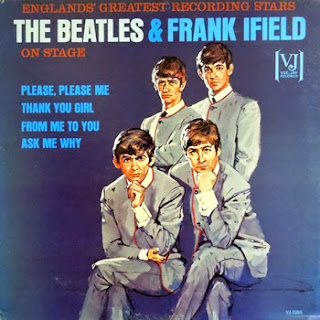Before his untimely death in August of 1967, manager Brian Epstein had set in motion a plan to build a company for his beloved Beatles. At the first meeting after his demise, the boys foolishly decided that they would now manage their own affairs while carrying on with Brian's master plan. Apple was naturally centered around the group's music, giving them their own record label, but it would also have other divisions including film, electronics and even a clothing boutique in London. However, Apple Records would still be distributed by EMI and its worldwide network of labels such as Parlophone, Odeon and, in America, Capitol Records.
The final single by the Beatles to appear on the orange and yellow Capitol label was the March 1968 release Lady Madonna b/w The Inner Light. Starting with the August '68 single Hey Jude b/w Revolution, the apple (shiny and whole on the front, cut in half on the B-side) became a familiar sight.
Capitol Records was now back in line with the British releases and remained so with the issue of the "White Album" in November of '68. The January 1969 soundtrack album Yellow Submarine was the same as far as the music goes, but Capitol deviated in the packaging. The back cover of the UK album reprinted a glowing review of the "White Album" from The Observer, deflecting attention from the obviously subpar record in the listener's hands. The American label chose instead to print an amusing bit of hype for the outstanding feature-length cartoon associated with the soundtrack, comparing the Beatles to some great heroes of yore.
The next single, Get Back b/w Don't Let Me Down in April of '69, was issued in mono in England, as all singles had been up to this point. But, giving in to the demands of the time, Capitol made the unprecedented step of issuing it in stereo, which would become the new norm in both countries beginning with the release of the single The Ballad of John and Yoko b/w Old Brown Shoe only a month later. In October of 1969, Capitol released the album Abbey Road and the double A-sided single Something/Come Together with no changes from the British originals.
But, at the same time, major changes were occurring for the Beatles. The group's attempt to manage its little empire for the past two years had been nothing short of disastrous and a nasty power struggle had taken place between McCartney and his bandmates over who should be brought in to keep everything they had from slipping away - either Paul's new in-laws Lee and John Eastman or brash American Allen Klein. After a brief period of joint management (to nobody's satisfaction), John, George and Ringo's choice eventually won out.
Amazingly, the Beatles, still the biggest act in show business worldwide, had mismanaged Apple so badly that they were now cash-poor. In an effort to improve revenues, Klein renegotiated the group's royalties deals yet again and eliminated the artistic agreement preventing Capitol from creating compilation albums and additional singles. The American label wasted little time and began putting together a new album...good thing, too, because unbeknownst to all except the group's inner circle, John had quit the Beatles.





































